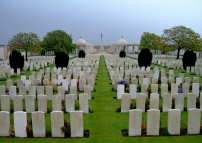| First Name: | Alfred | Last Name: | PEACHEY | |
|---|---|---|---|---|
| Date of Death: | 25/09/1915 | Lived/Born In: | Pentonville | |
| Rank: | Rifleman | Unit: | King's Royal Rifle Corps2 | |
| Memorial Site: | Loos Memorial, France | |||
Current Information:Age-36
5 Collier Street, Pentonville
The Battle of Loos, fought by the British Army from 25th September, 1915 through to 13th October, was conducted along a six-and-a-half-mile front running north from the mining village of Loos on the outskirts of Lens in Northern France. It was the largest offensive carried out by the British so far in the war. The opening day involved an attack by six divisions, with others entering the fray as it progressed and it was part of a much wider offensive with the French launching their own attacks in Champagne and at Vimy. It was the first time that the British used gas during the war, despite their condemnation of the Germans for doing the same in April 1915. There were some encouraging results on the first day but no major breakthrough was achieved and in the successive days the offensive became mired in trench warfare. By mid-October the battle had petered out with the British having suffered over 60,000 casualties during its course. 1st Division attacked along 1400 yards of front from a point opposite the Loos Road Redoubt to the Vermelles-Hulluch road. Jumping off trenches had been dug 300 yards in front of British line but the German trenches were still 300-400 yards off and on the other side of the crest of the Grenay ridge. To gain visibility, the Germans had run out saps and manned them with machine guns. At 5.50am on 25th September, 1915, a heavy British bombardment commenced and the gas cloud of chlorine was released. On 2 Brigade’s front the wind veered and the gas drifted back causing a number of casualties with 200 temporarily out of action but at 6.20am the wind changed back and the gas cylinders were turned on again. They attacked with 2nd King’s Royal Rifle Corps and 1st Loyal North Lancashire, still coughing and choking from the gas, on a front between North Sap and Lone Tree, a solitary cherry tree that had blossomed in May but was now just a stump 15 feet high. Almost straight away they were hit by machine gun fire from these two strongpoints but these were dealt with by British machine guns and the advance continued. With the German line over the crest and therefore not visible, the wire, 10 feet deep and staked low, had not been cut. Wire cutters were sent forward but were all shot down or bombed. All this gave the Germans time to emerge from their dug-outs and even send up reinforcements and as the British artillery fire had now moved on, they could man the front line and open heavy fire on 2 Brigade. The supporting waves fell back behind the crest and the impetus of the attack was lost. The leading ranks sought what cover they could find and there began a gradual retirement to original trenches. 2nd King’s Royal Rifle Corps suffered 460 casualties on this day. |
||||
| « Back to Search Results | ||||
| If you think any of the information shown here is incorrect, Click Here to submit your amends and comments | ||||




